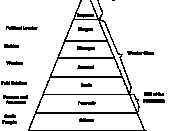According to the Anthropology book there are different groups that we as humans classify ourselves as. These groups are the ways in which humans classify themselves and are in all cultures. Some classify themselves by sex or gender. This is the grouping separating the males from the females in different societies. This is so familiar that it has been known as one of the only universal factors to determine a person's position in society. Others are grouped by age and is also very familiar, just like age grouping. Most nonliterate societies perform these age grouping rituals because of their traditions. One more group that people use is common-interest associations. This is a phenomenon associated with the rise of urban, industrialized societies where individuals are separated from their family. Social stratification is the division of society in two or more classes based on people that don't share resources, influence, or prestige.
These groups are used to deal with problems not handled by marriage, the family, and/or household, descent group, or kindred.
Grouping by gender or sex is very common, as stated above, in many cultures around the world. Some division of labor in gender is a characteristic in all human society. In some, men and women are segregated into groups of work assigned by sexes. In some cultures, men are the hunters, traders, fishers, and go to war and the women's jobs consist of jobs tending the garden, tending to children, getting fruits and vegetable and doing the housework. For example, the Iroquois in New York society was divided into two parts consisting of sedentary women and highly mobile men. The women's job was to grow beans, corn, and squash on which all Iroquois relied for food. The men's job consisted of hunting, fishing, trading, warring, and diplomacy. In some cultures,


